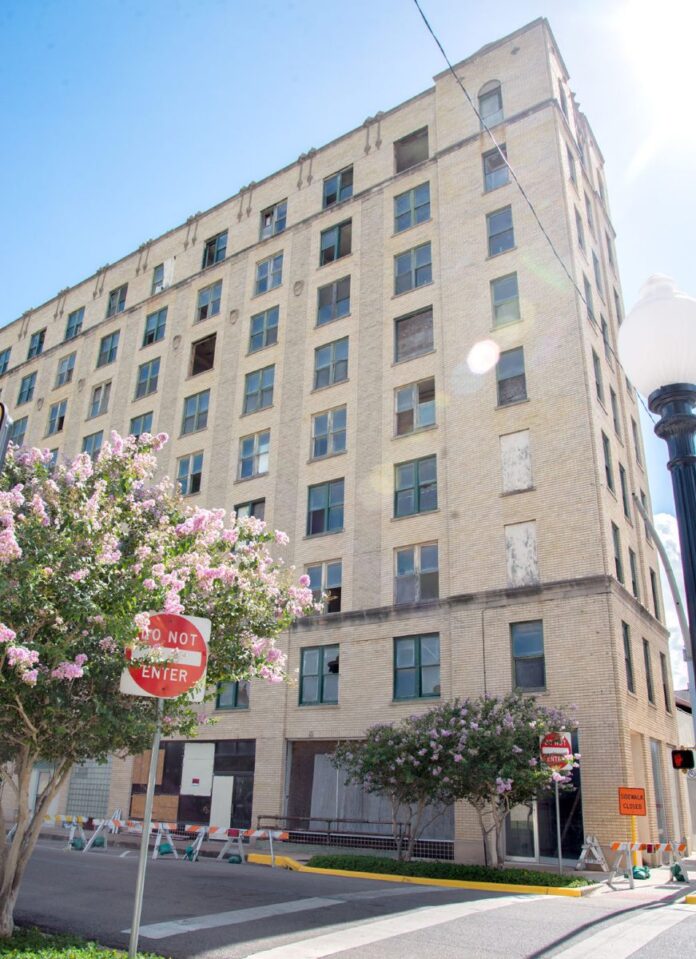HARLINGEN — Developers have appealed the state’s decision to deny federal tax credits for a $4.3 million project to turn the city’s tallest building into largely low-income apartments.
Last month, the Texas Department of Housing and Community Affairs denied MRE Capital’s request for $3.3 million in tax credits, arguing the developer had failed to adequately address project costs and property management and maintenance expenses as well as the 90-year-old Baxter Building’s structural condition.
On Sept. 7, the agency’s board of directors is expected to hear the appeal, said Jill McFarren, a spokeswoman in Austin.
“We’re going to present our appeal to the board for their consideration and hope for a favorable outcome,” City Manager Dan Serna said yesterday.
In a July 31 letter, MRE states it has had other projects that “followed the exact style, scope and length” that had qualified for federal tax credits.
MRE also argues its proposed project will rehab the nine-story building constructed in 1927.
“Ultimately, gut rehabs are very different than a standard rehabilitation project in scope and cost,” the letter states. “Other than the exterior skin and the main structure of the building, all systems will be new in year one …. A building such as Baxter Lofts, when renovated, more accurately acts as a new construction (all new systems) development within the body of a historic structure.”
MRE also stated its cost estimates are accurate.
“The developer and design team are intimate with the building and the scope and costs associated with the proposed Baxter Lofts,” the letter states.
As a result of the city’s $144,130 project in 2015, the roof is “in good condition and does not need to be replaced,” the letter states.
Roof replacement, it states, would be limited to the building’s one-story wing on its west side.
The city’s project also removed asbestos from the building, the letter states.
“This investment in the property means that the developer of the Baxter Lofts does not need to complete a full asbestos demolition and left only a small line item in its budget to prepare for any additional asbestos abatement that might come up during the demolition process,” the letter states.
On July 27, the agency’s board of directors denied the tax credits because the developer was “unable to assess major aspects of the cost of the development,” according to a state report.
According to the report, the developer “did not address likely costs not included in the project budget such as asbestos remediation, lead-based paint remediation, accessibility and fundamental concerns over the structure itself and whether its condition was sufficiently well known to … support the development of an appropriate scope of work.”
The report added, “the applicant’s proposed costs for property management and property maintenance (was) materially out of line with industry norms as to be beyond what they could accept.”
– Developer experience in similar projects
– City’s project to remove asbestos
– Project would create like-new construction
This is the second time the developers have requested federal tax credits to help fund the Baxter Lofts project.
Last year, the project scored low partly because prospective Baxter tenants’ children would attend Harlingen High School, which ranked below state academic standards.
Because the agency had coupled its public education criteria with its historical preservation points, the project lost critical marks.
This year, the agency revised criteria helped to project to score high.
The state agency’s staff used its criteria to give the project 156 points, tying MRE Capital’s proposed Brownsville project while 12 other projects scored 155 points in Region 11.
Mayor Chris Boswell has called the project to renovate one of the city biggest eyesores critical to the continued revitalization of the downtown area.
But downtown property owners have opposed the project, arguing a 24-unit apartment development would bring too many families that would park their cars in front of businesses, taking parking spaces from shoppers in the small business district.




